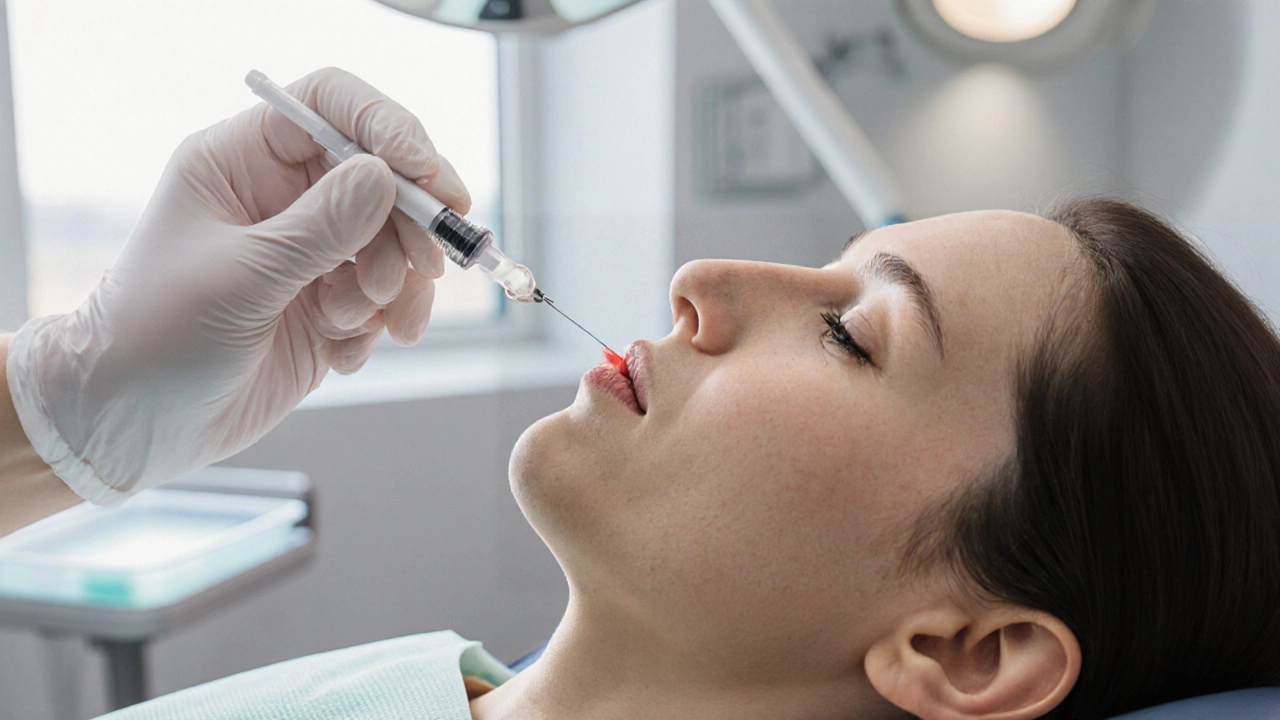Do Dental Implants Require You to Be Put to Sleep?
 Oct, 23 2025
Oct, 23 2025
Dental Implant Anesthesia Cost Calculator
Anesthesia Type Selection
When you hear the words dental implant anesthesia, a common image pops up: a patient lying flat, eyes closed, a mask over the face. But is that really what happens for most implant procedures? The truth is a blend of science, patient comfort, and the skill of the oral surgeon. Below we break down when you’ll be fully asleep, when a numbing jab is enough, and how each choice affects your day‑to‑day life.
What Exactly Are Dental Implants?
Dental implants is a restorative dental procedure that replaces missing teeth with titanium fixtures anchored in the jawbone. The fixture acts like a tooth root, a crown snaps on top, and the whole set feels and works like a real tooth. In the UK, over 150,000 people receive implants each year, and the success rate hovers around 95 % when proper protocols are followed.
Do You Need to Be Put to Sleep?
The short answer: most people are not put under general anesthesia for standard implant placement. Instead, the majority of clinicians rely on Local anesthesia alone or pair it with a mild sedation technique. The decision hinges on three factors:
- Complexity of the case - multiple implants, bone grafting, or sinus lifts often merit deeper sedation.
- Patient anxiety - someone who clutches the chair may benefit from Conscious sedation.
- Medical history - certain heart or lung conditions make deep sedation riskier, steering the surgeon toward a simple local block.
In a typical single‑tooth implant, a dentist injects a numbing solution around the surgical site, and the patient stays fully awake, only feeling a brief pressure.
Types of Anesthesia Used in Implant Surgery
| Option | Level of Consciousness | Typical Drugs | Recovery Time | Average Cost (UK) |
|---|---|---|---|---|
| Local anesthesia | Fully aware | Lidocaine, Articaine | 30‑45 min | £50‑£150 |
| Conscious sedation | Relaxed, responsive | Midazolam, Nitrous oxide | 1‑2 hours | £150‑£400 |
| General anesthesia | Completely asleep | Propofol, Sevoflurane | 2‑4 hours | £500‑£1,200 |
Local Anesthesia - The Most Common Choice
When the implant sits in healthy bone without extra procedures, dentists typically use a local anesthetic. A thin needle delivers lidocaine around the gum tissue, numbing the area in about 2 minutes. You’ll still hear the drill, but you won’t feel the pain. Advantages include:
- Fast onset and quick recovery.
- Low risk of complications.
- No need for an IV line.
Drawbacks are limited to discomfort from the injection itself, which most patients tolerate well.

Conscious Sedation - “Twilight” Dentistry
Also called “twilight dentistry,” conscious sedation blends a low dose of an oral medication like Midazolam with inhaled Nitrous oxide. You stay awake enough to answer simple questions, but anxiety melts away and the sense of time blurs.
Typical scenarios that trigger sedation include:
- Multiple implants in one session.
- Bone grafting or sinus lift procedures.
- Patients with a strong gag reflex.
Recovery usually means waiting in a recovery area for about an hour before you can drive home. The main caution: you must arrange a sober driver.
General Anesthesia - When Full Sleep Is Required
General anesthesia is reserved for the most extensive surgeries or for patients who cannot cooperate under lighter techniques. An anesthesiologist administers a drug cocktail that puts you into a controlled coma. You won’t remember the procedure at all.
Because the airway is managed with a breathing tube, the setting is usually a hospital or a surgical centre with full monitoring equipment. The cost is higher, and the recovery period can stretch to several hours, sometimes requiring an overnight stay.
Medical conditions that push clinicians toward general anesthesia include severe heart disease, uncontrolled epilepsy, or extreme claustrophobia that makes a dental chair untenable.
How to Prepare for Your Chosen Anesthesia
Regardless of the technique, a few universal prep steps improve safety:
- Share a complete medication list - blood thinners, anti‑inflammatories, and herbal supplements can interfere with bleeding control.
- Follow fasting instructions if you’re getting sedation or general anesthesia - typically no solid food for 6 hours, clear liquids up to 2 hours before.
- Arrange post‑procedure transport and someone to stay with you for the first 24 hours if you received sedation.
On the day of surgery, the oral surgeon will review your medical history, take vital signs, and confirm the anesthesia plan.

Recovery: What to Expect After the Procedure
After local anesthesia, most patients walk out of the clinic within 30 minutes, apply a cold pack, and take over‑the‑counter pain relievers. Swelling typically peaks at 48 hours and fades by the end of the first week.
With conscious sedation, you’ll spend a short time in a recovery chair. You might feel drowsy for the next 4‑6 hours, so plan light activities and avoid alcohol.
General anesthesia recovery can involve a brief stay in a post‑anesthesia care unit (PACU). Nausea is the most common side effect, often resolved with anti‑emetics.
For any anesthesia type, keep the surgical site clean, stick to soft foods for a couple of days, and avoid smoking - it impairs bone healing.
Cost Considerations and Insurance Coverage
In the UK, many dental implant procedures are partially covered by NHS contracts for specific cases, but most patients pay privately. Anesthesia adds an extra line item to the invoice. When comparing quotes, ask the clinic for a detailed breakdown that separates the implant fixture, surgical lab work, and anesthesia fees.
Some private dental insurers reimburse a portion of the sedation cost if it is medically justified. Keep a copy of the treatment plan and the dentist’s note explaining why sedation was chosen; this paperwork smooths the claim process.
Key Takeaways
- Most single‑tooth implants are done with only local anesthesia.
- Conscious sedation offers a middle ground for anxious patients or multi‑implant cases.
- General anesthesia is reserved for complex surgeries or special medical needs.
- Preparation, honest medical disclosure, and post‑op care are essential for a smooth recovery.
Will I be awake during implant surgery?
Most implant placements use local anesthesia, so you stay awake but feel no pain. Sedation may be added if you’re anxious or need multiple implants.
How long does the numbness last?
The numb feeling typically wears off within 2‑4 hours, but it can linger a bit longer if a higher dose was used.
Can I drive after conscious sedation?
No. The medication reduces reaction time, so you need a sober driver for at least 24 hours.
Is general anesthesia safe for dental implants?
It is safe when performed by a qualified anesthesiologist in a monitored setting. The main concerns are related to your overall health, not the implant itself.
What should I eat after the procedure?
Soft foods like yogurt, scrambled eggs, and smoothies work best for the first 48 hours. Avoid hot, crunchy, or spicy items until swelling subsides.